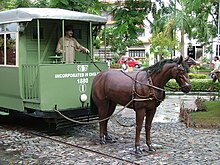Calcutta Tramways Company
This article needs additional citations for verification. (January 2018) |
 CTC Logo | |
 Kolkata Tram as of today | |
| Company type | Tram network |
|---|---|
| Founded | 1880[1] |
| Defunct | 2016 |
| Fate | Merged with WBTC |
| Successor | West Bengal Transport Corporation |
| Headquarters | , |
Area served | Kolkata |
| Services | Tram, Bus |
| Owner | Government of West Bengal |
| Parent | Calcutta Tramways Company (England) |
| Website | calcuttatramways |
Calcutta Tramways Company (CTC) was a state-run company that operated trams and buses in and around Kolkata (formerly known as Calcutta) in West Bengal, India. The Kolkata tram is the only operating tramway in India and is the oldest electric tram in India, operating since 1902.[2][3][4]
CTC has been merged into WBTC since 2016.[5]
History
[edit]
The first horse-drawn trams in India ran for 2.4 miles (3.9 km) between Sealdah and Armenian Ghat Street on 24 February 1873. The service was discontinued on 20 November of that year.[1] The Calcutta Tramway Company was formed and registered in London on 22 December 1880. Metre-gauge horse-drawn tram tracks were laid from Sealdah to Armenian Ghat via Bowbazar Street, Dalhousie Square and Strand Road. The route was inaugurated by the Viceroy, Lord Ripon, on 1 November 1880.[1] In 1882, steam locomotives were deployed experimentally to haul tram cars.[1]

In 1900, the electrification of the tramway and conversion of its tracks to 4 ft 8+1⁄2 in (1,435 mm) (standard gauge) began.[1] The first electric tramcar in Calcutta ran from Esplanade to Kidderpore on 27 March 1902. In February 1943, the Calcutta and Howrah sections were connected by the new Howrah Bridge.[1]
In 1951, the government of West Bengal entered an agreement with the Calcutta Tramways Company and the Calcutta Tramways Act of 1951 was enacted. The government assumed the tramways, reserving the right to purchase the system with two years' notice on 1 January 1972 or at any time thereafter.[1] In 1967, the Government of West Bengal passed the Calcutta Tramways Company (Taking Over of Management) Act and assumed management on 19 July. On 8 November 1976, the Calcutta Tramways (Acquisition of Undertaking) ordinance was promulgated under which the company (and its assets) was nationalised.[1]
The Tramways system had degraded by the 1990s, and Minister for Transport Shyamal Chakraborty planned to close the network. In the meantime, Calcutta Tramways Company introduced bus service on 4 November 1992 with a fleet of 40 buses.[1] However, Melbourne tram conductor Roberto D'Andrea befriended fellow Calcutta conductors during a 1994 visit. When D'Andrea heard about the planned closure of tram network, he suggested an art project to decorate the trams (as was done in his home city). The project increased public awareness of the tram network and its value, ultimately saving it.[6]
Trams
[edit]The Calcutta Tramways Company Ltd operates the Kolkata tram, currently the oldest electric tramway in Asia and India's only existent tram system, since 1880.
Buses
[edit]With over 45 routes throughout Kolkata and its surrounding areas, CTC buses complement its tram service. The initial bus service was introduced from Rajabazar with a fleet of 40 buses, augmented in 1993 with service from Kidderpore depot.[1] The Tollygunge and Belgachia depots were added in 1994 and 1995, respectively. In 2005 the CTC began bus service from Ghasbagan depot at Howrah.
Depots, terminals and workshops
[edit]There are five tram depots: Rajabazar, Gariahat, Tollygunge, Kalighat and Khidirpur. Rajabazar and Tollygunge depots are the largest in terms of tracks and area, respectively. Khidirpur depot is the oldest and Kalighat depot is the smallest. There were tram depots at Ghasbagan, Belgachhia, Park Circus and Joka which are now converted into CTC bus depots. There are also CTC bus depots in Barasat, Habra and Titagarh.
There are six tram terminals: Shyambazar, Bidhan Nagar Road, Ballygunge Station, Esplanade, B.B.D. Bagh (currently closed, work going on resume its services again) and Howrah Bridge. The Esplanade terminus serves most of the tram routes. Former tram terminals, all now either closed or converted into bus depots and terminals, had been at Shibpur, Bandhaghat, Bagbazar, Galiff Street, Kolkata High Court, Nimtala, Behala, Sealdah Station, Howrah Station, Planetarium and Racecourse.
There is one workshop: Nonapukur.
Routes
[edit]2 routes currently operate in Kolkata. Recently AC tram was also introduced.[7][8]
See also
[edit]References
[edit]- ^ a b c d e f g h i j [1] Archived 27 September 2013 at the Wayback Machine CTC website. Accessed 16 August 2013.
- ^ "Kolkata trams to get a GenX makeover". The Times of India. 13 July 2012. Archived from the original on 27 September 2013.
- ^ "Reaching India". New Delhi: Times Internet Limited. Archived from the original on 16 October 2007. Retrieved 27 February 2012.
- ^ "Special tram rides to commemorate Rabindranath Tagore's Nobel prize". The Economic Times.
- ^ West Bengal Transport Corporation constituted – CSTC, CTC and WBSTC merged in to WBTC
- ^ "Tramjatra: The story of the Melbourne conductor who helped save Kolkata's trams - ABC News". Australian Broadcasting Corporation. 6 October 2016.
- ^ "Gariahat Flyover".
- ^ "calcuttatramways/routes.com".
Notes
[edit]- Niyogi, S. Shake, rattle & roll. The Sunday Story, Sunday Times of India, Kolkata, 25 June 2006. Available on Times of India e-paper (paid subscription required as of 2010).
- Pathak Pratap Shankar, The Sunday Story, Sunday Times of India, Kolkata.
External links
[edit]- Official website of Calcutta Tramways Company
- Urbanrail.net page with schematic map of trams in Kolkata
- Geographical map of trams in Kolkata, both past and latest updates
- Photos of trams in Kolkata Archived 25 March 2017 at the Wayback Machine
- Department of Transport from the Government of West Bengal website
- Documents and clippings about Calcutta Tramways Company in the 20th Century Press Archives of the ZBW
